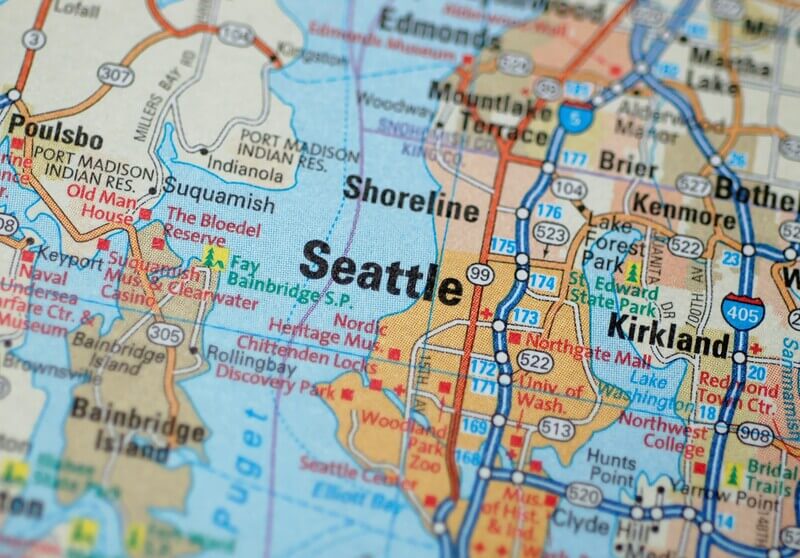
Table of Contents
This article was written to help make moving to Seattle a simple and affordable mission for everyone. We give you our best local tips about the best neighborhoods to consider for relocation as a couple.
We also give our key general moving tips to keep things affordable. Our local neighborhood guide will help you figure out where to settle down.
Moving to Seattle: Pricing Van Lines Breaks it Down
Moving to Seattle with your new partner is an exciting adventure! Planning things right can help save relationship issues and arguments.
Here’s a guide to help you navigate the move together and find the right neighborhood for you and your partner. Love is in the air.
Seattle Our Love
Seattle is known for its impressive natural beauty, vibrant culture, and growing tech scene. It is known as a super liberal city and usually a hot spot for local protests and key political issues.
If you are an activist this is the spot to be active! The city is surrounded by water, mountains, and forests, making it the perfect place for outdoor enthusiasts.
It has a diverse population that brings many incredible foods from all cultures and a variety of neighborhoods, each with its own unique character.
Moving Guide: Pricing Van Lines
The best thing you can do is plan ahead. Read on to understand where to start!
1. Planning Your Move
Research Neighborhoods: Explore areas that fit your lifestyle and budget. Consider factors like commute times to your offices, proximity to gyms and religious centers, amenities you are used to from your old city, and overall vibe.
- Our number one tip is to actually spend a few days in an airbnb in each area to get a feel for the actual daily life. Try out gym classes and sign up for the many activities and clubs there to try out your new future life.
Budget: Factor in costs such as local rent in the area you are considering, utilities, groceries, and transportation. Seattle’s cost of living can be high, especially in popular areas. Make sure you can afford that neighborhood of your dreams.
Timeline: Create a moving timeline that includes finding a place, packing, and moving day logistics. Make it actually attainable taking into consideration any holidays, life events and your daily job stresses.
2. Finding Your Perfect Place to Live
Rent vs. Buy: Determine if renting or buying is right for you. Most new couples choose to rent initially. This gives you the freedom to move again whenever you need if you aren’t happy with your initial neighborhood.
Real Estate Agents: Consider requesting assistance from an agent familiar with Seattle’s neighbourhoods if you’re buying or need help navigating the rental market and don’t mind paying for this service.
3. Logistics
Hire Movers or DIY: Decide whether to hire a long-distance moving company or do it yourself with friends and family. Get quotes from Pricing Van Lines and check reviews.
- The earlier you book with Pricing Van Lines, the more discounts you’ll be able to lock down, as movers love to have their schedules booked up ahead.
- Try booking mid-week dates in the offseasons (during the school year and winter months will help you save hundreds).
Packing: Start early, declutter, and organize your belongings. Use quality packing materials. Start early gathering all you will need so that when the mood to pack strikes, you will be ready!
Utilities: Set up utilities (electricity, water, internet) in advance. Seattle has several providers, so research which ones are best for your needs. Make sure to transfer your old utilities to the new renter of you current home and pay off any last bills.
Neighborhoods to Consider As A Couple
1. South Lake Union
Vibe: Tech spot with modern living for high-tech couples. Lots of cafes and restaurants for meetings.
Pros: Proximity to major work offices like Amazon; and waterfront parks. Great gardens all around but very conveniently placed amenities.
Cons: Higher cost of living, and it can feel very corporate. If you work from morning until night this is the ideal spot to not waste your time commuting.
2. West Seattle
Vibe: Laid-back vibes, with a strong community feel. A great place to find your new friends and set up shop. West Seattle is a great place to get away from the hustle and bustle.
Pros: Beautiful views of the city skyline and beach access. See the stress from afar while enjoying your book on the beach.
Cons: Longer commute times to downtown for work.
3. Capitol Hill
Vibe: Energetic and different than the rest, with a great Seattle nightlife if you are young and in the part mood this is a perfect area.
Pros: Close to restaurants, bars, and cultural venues; great public transit.
Cons: Higher rent prices and noisy depending on the street. Make sure to head there at night before closing a place to ensure you can’t hear the bars.
4. Ballard
Vibe: A perfect mix of hipster and seaside charm. This is an ideal spot for couples looking to settle down in a fun area and bring kids in the coming years.
Pros: Trendy shops, breweries, and farmers’ markets; family-friendly.
Cons: Can be expensive, especially near the water. Other than the price the area doesn’t really have many cons.
5. Queen Anne
Vibe: Historic and upscale vibes, with great views of the city center.
Pros: Quiet neighborhood and great schools if you are planning to have young ones. Close to Seattle Center so the work commute isn’t an issue.
Cons: Expensive housing both in the rental and buying markers and limited public transport. Some parking is limited.
6. University District
Vibe: Lively, student-oriented area. Perfect if you are in your studies or simple wanting to be in a younger area.
Pros: Many different dining options and cultural events. Everything is walkable. Perfect if you are working remotely and love cafes.
Cons: Can be noisy and busy during the school year. The neighborhood can feel very young and college vibes so make sure this fits the right time in your life.
Tips for Settling In Seattle
- Explore Local Events: Check out local events, farmers’ markets, and festivals to meet people and immerse yourself in the community. You can find out about them in the local community centers on FB local groups.
- Transport: Seattle has a good public transit system (buses, light rail, ferries). Consider getting an private car if you are outside the major city areas and for convenience to be able to enjoy weekend nature trips.
- Outdoor Lovers Paradise: Take advantage of the beautiful surroundings every single weekend! Go hiking, kayaking, and visit the many parks.
- Food: Seattle is known for its coffee, seafood, and great cuisine. Explore neighborhoods for local eateries and food trucks for the tacos.
While Seattle offers many advantages, there are also potential drawbacks to consider. The high cost of living, frequent rainfall, and traffic congestion may be a drain, but if you’re okay with gray skies and you’re making that Microsoft money, you may be able to take everything in stride.
Final Thoughts on Seattle Relocation
Moving to Seattle as a couple will be a fun and bonding experience with the right preparation and the right partner. Take your time to explore the many different neighborhoods, and don’t hesitate to reach out to locals for tips.
Enjoy your new adventure by preparing in advance for the move to save! Of course book your movers with Pricing Van Lines if affordable and professional movers is what you are looking for.
Frequently Asked Questions
Should I use the full packing option that Pricing Van Lines offers?
Professional packers are not a must, but they will work at incredible speeds to pack all your items safely. Think about the time you will save by not sorting through all your home goods from the past years.
Our movers will have your entire home packed up and bubble-wrapped in no time. If you are in a time crunch, in the midst of important work projects, or just want to feel like a VIP customer, consider using a packing full service moving option.
As well, consider the fact that you will likely break some of your delicates if you lack packing experience so you may save overall by choosing the full service package. You will also save yourself the time of searching for old boxes and supplies.
Why should you create a moving inventory list?
Having your own moving inventory list is likely to be helpful for insurance claims and just to keep things clear when packing and unpacking. It is a worst case scenario savior.
As much as we know we are working with trusted movers, there is nothing as valuable as written data so that when memory fails us, we can still find our key items. iMoving is here to help you move with ease and stress-free.
Be sure to take a slow and detailed video of your home before beginning to pack so that you can remember how to best unpack your items via your list.
What is the most important thing to do before moving?
Plan ahead of time your moving schedule and checklist and book your affordable movers to keep prices in line with your budget. Planning ahead and getting rid of all that excess clutter before moving day will save you more than you would ever imagine. Don’t take my word for it, check out our clients tips and tricks!
What can I do if I can’t find time to pack up the house?
If you’ve done your own packing before, you know how long it really takes. If you’ve never had to deal with it, well… just take our word for it. Packing is a pain and very time consuming. Luckily, you can book cheap packing with Pricing Van Lines.
As an optional extra, our movers will show up with boxes, tape, bubble wrap, and all that other stuff to keep everything safe and sound. The best part? It only costs a fraction of what the other guys will charge you.
What can I do if I have too many items for my new home, but no time to sort through things?
Storage units are the answer! They will give you a whole lot of extra square footage and flexibility, before, during, and after the move. There is a whole range of units of all shapes and sizes – not to mention climate-controlled options, we’ve got the storage options you need for a successful relocation. You can take the time later to organize your unit.



